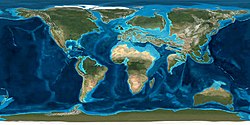Ypresian
| Ypresian | |||||||||||||
|---|---|---|---|---|---|---|---|---|---|---|---|---|---|
 Earth ~50 mya | |||||||||||||
 | |||||||||||||
| Chronology | |||||||||||||
| |||||||||||||
| Formerly part of | Tertiary Period/System | ||||||||||||
| Etymology | |||||||||||||
| Name formality | Formal | ||||||||||||
| Usage information | |||||||||||||
| Celestial body | Earth | ||||||||||||
| Regional usage | Global (ICS) | ||||||||||||
| Time scale(s) used | ICS Time Scale | ||||||||||||
| Definition | |||||||||||||
| Chronological unit | Age | ||||||||||||
| Stratigraphic unit | Stage | ||||||||||||
| First proposed by | Dumont | ||||||||||||
| Time span formality | Formal | ||||||||||||
| Lower boundary definition | Strong negative anomaly in δ13C values at the PETM[3] | ||||||||||||
| Lower boundary GSSP | Dababiya section, Luxor, Egypt[3] 25°30′00″N 32°31′52″E / 25.5000°N 32.5311°E | ||||||||||||
| GSSP ratified | 2003[3] | ||||||||||||
| Upper boundary definition | FAD of the calcareous nannofossil | ||||||||||||
| Upper boundary GSSP | Gorrondatxe section, Western Pyrenees, Basque Country, Spain 43°22′47″N 3°00′51″W / 43.3796°N 3.0143°W | ||||||||||||
| GSSP ratified | April 2011[4] | ||||||||||||
In the geologic timescale the Ypresian is the oldest age or lowest stratigraphic stage of the Eocene. It spans the time between 56 and 47.8 Ma, is preceded by the Thanetian Age (part of the Paleocene) and is followed by the Eocene Lutetian Age. The Ypresian is consistent with the lower Eocene.
Events[]
The Ypresian Age begins during the throes of the Paleocene–Eocene Thermal Maximum (PETM). The Fur Formation in Denmark, the Messel shales in Germany, the of France and of India are of this age.
Stratigraphic definition[]
The Ypresian Stage was introduced in scientific literature by Belgian geologist André Hubert Dumont in 1850. The Ypresian is named after the Flemish city of Ypres in Belgium (spelled Ieper in Dutch). The definitions of the original stage were totally different from the modern ones.[5] The Ypresian shares its name with the Belgian Ieper Group (French: Groupe d'Ypres), which has an Ypresian age.
The base of the Ypresian Stage is defined at a strong negative anomaly in δ13C values at the PETM. The official reference profile (GSSP) for the base of the Ypresian is the Dababiya profile near the Egyptian city of Luxor.[6] Its original type section was located in the vicinity of Ieper.
The top of the Ypresian (the base of the Lutetian) is identified by the first appearance of the foraminifera genus Hantkenina in the fossil record.
The Ypresian Stage overlaps the upper Neustrian and most of the Grauvian European Land Mammal Mega Zones (it spans the Mammal Paleogene zones 7 through 10.[7]), the Wasatchian and lower and middle Bridgerian North American Land Mammal Ages, the Casamayoran South American Land Mammal Age and the Bumbanian and most of the Arshantan Asian Land Mammal Ages. It is also coeval with the upper Wangerripian and lowest Johannian regional stages of Australia and the , Penutian and Ulatisian regional stages of California.
References[]
- ^ Zachos, J. C.; Kump, L. R. (2005). "Carbon cycle feedbacks and the initiation of Antarctic glaciation in the earliest Oligocene". Global and Planetary Change. 47 (1): 51–66. Bibcode:2005GPC....47...51Z. doi:10.1016/j.gloplacha.2005.01.001.
- ^ "International Chronostratigraphic Chart" (PDF). International Commission on Stratigraphy.
- ^ a b c Aubry, Marie-Pierre; Ouda, Khaled; Dupuis, Christian; William A. Berggren; John A. Van Couvering; Working Group on the Paleocene/Eocene Boundary (2007). "The Global Standard Stratotype-section and Point (GSSP) for the base of the Eocene Series in the Dababiya section (Egypt)" (PDF). Episodes. 30 (4): 271–286. doi:10.18814/epiiugs/2007/v30i4/003.
- ^ Molina, Eustoquio; Alegret, Laia; Apellaniz, Estibaliz; Bernaola, Gilen; Caballero, Fernando; Jaume Dinarès-Turell; Hardenbol, Jan; Claus Heilmann-Clausen; Juan C. Larrasoana; Hanspeter Luterbacher; Simonetta Monechi; Silvia Ortiz; Xabier Orue-Etxebarria; Aitor Payros; Victoriano Pujalte; Francisco J. Rodríguez-Tobar; Flavia Tori; Josep Tosquella; Alfred Uchman (2011). "The Global Stratotype Section and Point (GSSP) for the base of the Lutetian Stage at the Gorrondatxe section, Spain" (PDF). Episodes. 34 (2): 86–108. doi:10.18814/epiiugs/2011/v34i2/006.
- ^ Steurbaut (2006)
- ^ The GSSP was established by Dupuis et al. (2003)
- ^ Alroy, John. "Mammal Paleogene zones". p. The Paleobiology Database. Retrieved 15 July 2009.
Literature[]
| Wikisource has original works on the topic: Cenozoic#Paleogene |
- Dumont, A. H.; 1850: Rapport sur la carte géologique du Royaume, Bulletins de l’Académie Royale des Sciences, des Lettres et des Beaux-Arts de Belgique 16 (2), pp. 351–373. (in French)
- Dupuis, C.; Aubry, M.; Steurbaut, É; Berggren, W. A.; Ouda, K.; Magioncalda, R.; Cramer, B. S.; Kent, D. V.; Speijer, R. P. & Heilmann-Clausen, C.; 2003: The Dababiya Quarry Section: Lithostratigraphy, clay mineralogy, geochemistry and paleontology, Micropaleontology 49 (1), pp. 41–59, ISSN 0026-2803.
- Gradstein, F. M.; Ogg, J. G. & Smith, A. G.; 2004: A Geologic Time Scale 2004, Cambridge University Press.
- Steurbaut, É.; 2006: Ypresian, Geologica Belgica 9 (1–2), pp. 73–93.
External links[]
- GeoWhen Database – Ypresian
- Paleogene timescale, at the website of the subcommission for stratigraphic information of the ICS
- Stratigraphic chart of the Paleogene, at the website of Norges Network of offshore records of geology and stratigraphy
- Ypresian
- Eocene geochronology
- Ypresian first appearances
- Geological ages
